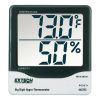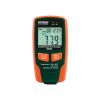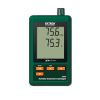Onset HOBO MX Temp/RH Logger
Features
- Stores 84,000 measurements
- Easy to deploy and offload using the free HOBOconnect app
- Visual and audible high & low alarm thresholds
- Expedited repair and warranty service
- Lifetime technical support
- More
Overview
The Onset HOBO MX1101 data logger measures and transmits temperature and relative humidity data wirelessly to mobile devices or Windows computers via Bluetooth Low Energy (BLE) technology. Add the MX Gateway for remote access to data in Onset's cloud-based HOBOlink software.
Mechanics
The self-contained wireless data logger works with a mobile device or Windows computer and Onset's free HOBOconnect app so users can configure the logger and read out data over a 100-foot range, with no other dedicated equipment required. Using Onset's free app, users can also view data in graphs, check the operational status of loggers, configure alarm notifications, and share data files.
| Temperature Sensor | |
| Range | -20° to 70°C (-4° to 158°F) |
| Accuracy | ±0.21°C from 0° to 50°C (±0.38°F from 32° to 122°F) |
| Resolution | 0.024°C at 25°C (0.04°F at 77°F) |
| Drift | <0.1°C (0.18°F) per year |
| RH Sensor* | |
| Range | 1% to 90%, non-condensing |
| Accuracy | ±2.0% from 20% RH to 80% RH typical to a maximum of ±4.5% including hysteresis at 25˚C (77˚F); below 20% RH and above 80% RH ±6% typical |
| Resolution | 0.01% |
| Drift | <1% per year typical |
| Response Time | |
| Temperature | 7:30 minutes in air moving 1 m/s (2.2 mph) |
| RH | 20 seconds to 90% in airflow of 1 m/s (2.2 mph) |
| Logger | |
| Radio Power | 1 mW (0 dBm) |
| Transmission Range | Approximately 30.5 m (100 ft) line-of-sight |
| Wireless Data Standard | Bluetooth Smart (Bluetooth Low Energy, Bluetooth 4.0) |
| Logger Operating Range | -20° to 70°C (-4° to 158°F); 0 to 95% RH (non-condensing) |
| Logging Rate | 1 second to 18 hours |
| Logging Modes | Fixed interval (normal, statistics) or burst |
| Memory Modes | Wrap when full or stop when full |
| Start Modes | Immediate, push button, date & time, or next interval |
| Stop Modes | When memory full, push button, date & time, or after a set logging period |
| Restart Mode | Push button |
| Time Accuracy | ±1 minute per month at 25°C (77°F) |
| Battery Life | 1 year, typical with logging interval of 1 minute. Faster logging and/or statistics sampling intervals, entering burst logging mode, and remaining connected with the app will impact battery life. Excessive readouts, audible alarms, and paging all impact battery life. Visual alarms and other events can have a marginal impact on battery life. |
| Battery Type | Two AAA 1.5 V alkaline batteries, user replaceable |
| Memory | 128 KB (84,650 measurements, maximum) |
| Full Memory Download Time | Approximately 60 seconds; may take longer the further the device is from the logger |
| LCD | LCD is visible from 0° to 50°C (32° to 122°F); the LCD may react slowly or go blank in temperatures outside this range |
| Size | 3.66 x 8.48 x 2.29 cm (1.44 x 3.34 x 0.9 in.) |
| Weight | 56 g (1.98 oz) |
| Environmental Rating | IP50 |
- HOBO MX1101 Temp/RH Data Logger
- Command strip
- Double-sided tape
- Hook & loop strap
- Two AAA 1.5 V alkaline batteries
In The News
Save our Bogs! Culture, Conservation and Climate Action in Ireland’s Peatlands
Characterized by long-term accumulation under waterlogged conditions, peatlands exist on every continent and account for 3-4% of the global land surface . Small but mighty, these often overlooked wetland environments are estimated to hold as much as one-third of the world's organic carbon in their soil—twice the amount found in the entirety of the Earth's forest biomass. While healthy peatlands can trap and store carbon, regulate water, and provide important habitats for rare species, human alteration has disturbed peatland carbon and nitrogen cycles on a global scale. Approximately 12% of the world’s peatlands have been drained and degraded through conversion for agriculture, forestry, infrastructure development, and other uses.
Read MoreSargassum Surge: How Seaweed is Transforming our Oceans and Coastal Ecosystems
Until recently, Sargassum –a free-floating seaweed–was distributed throughout the Sargasso Sea , the north Caribbean Sea, and the Gulf of Mexico. But in the space of a decade, this seaweed has, as one scientist remarks , “Gone from a nonfactor to the source of a terrible crisis.” Driven by climate change, anomalous North Atlantic Oscillation in 2009-2010 and a glut of anthropogenic pollutants, sargassum has proliferated. Seasonally recurrent mats as deep as 7m now bloom in the “Great Atlantic Sargassum Belt” (GASB), which covers areas of the Atlantic from West Africa to the Caribbean Sea and Gulf of Mexico. Every year, millions of tons wash up along the shores of more than 30 countries . Dr.
Read MoreGreat Lakes Research Center: Designing Targeted Monitoring Solutions
According to the National Oceanic and Atmospheric Administration ( NOAA ), the Great Lakes have more miles of coastline than the contiguous Atlantic and Pacific coasts combined and contain 20 percent of the world's freshwater, making it a critical region to protect and conserve. Continuous monitoring and data-informed resource management are key components of managing waters in the region. Hayden Henderson, a research engineer with the Great Lakes Research Center (GLRC), designs and deploys monitoring platforms throughout the Great Lakes. With a background in environmental engineering, Henderson enjoyed the challenge of creating systems and making them work to obtain difficult, remote measurements.
Read More















